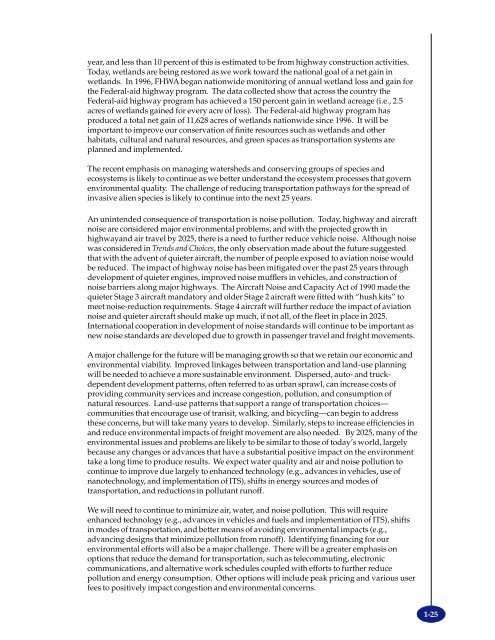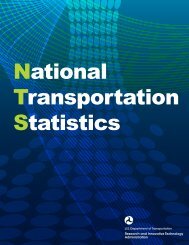TRANSPORTATION - BTS - Bureau of Transportation Statistics
TRANSPORTATION - BTS - Bureau of Transportation Statistics
TRANSPORTATION - BTS - Bureau of Transportation Statistics
You also want an ePaper? Increase the reach of your titles
YUMPU automatically turns print PDFs into web optimized ePapers that Google loves.
year, and less than 10 percent <strong>of</strong> this is estimated to be from highway construction activities.Today, wetlands are being restored as we work toward the national goal <strong>of</strong> a net gain inwetlands. In 1996, FHWA began nationwide monitoring <strong>of</strong> annual wetland loss and gain forthe Federal-aid highway program. The data collected show that across the country theFederal-aid highway program has achieved a 150 percent gain in wetland acreage (i.e., 2.5acres <strong>of</strong> wetlands gained for every acre <strong>of</strong> loss). The Federal-aid highway program hasproduced a total net gain <strong>of</strong> 11,628 acres <strong>of</strong> wetlands nationwide since 1996. It will beimportant to improve our conservation <strong>of</strong> finite resources such as wetlands and otherhabitats, cultural and natural resources, and green spaces as transportation systems areplanned and implemented.The recent emphasis on managing watersheds and conserving groups <strong>of</strong> species andecosystems is likely to continue as we better understand the ecosystem processes that governenvironmental quality. The challenge <strong>of</strong> reducing transportation pathways for the spread <strong>of</strong>invasive alien species is likely to continue into the next 25 years.An unintended consequence <strong>of</strong> transportation is noise pollution. Today, highway and aircraftnoise are considered major environmental problems, and with the projected growth inhighwayand air travel by 2025, there is a need to further reduce vehicle noise. Although noisewas considered in Trends and Choices, the only observation made about the future suggestedthat with the advent <strong>of</strong> quieter aircraft, the number <strong>of</strong> people exposed to aviation noise wouldbe reduced. The impact <strong>of</strong> highway noise has been mitigated over the past 25 years throughdevelopment <strong>of</strong> quieter engines, improved noise mufflers in vehicles, and construction <strong>of</strong>noise barriers along major highways. The Aircraft Noise and Capacity Act <strong>of</strong> 1990 made thequieter Stage 3 aircraft mandatory and older Stage 2 aircraft were fitted with “hush kits” tomeet noise-reduction requirements. Stage 4 aircraft will further reduce the impact <strong>of</strong> aviationnoise and quieter aircraft should make up much, if not all, <strong>of</strong> the fleet in place in 2025.International cooperation in development <strong>of</strong> noise standards will continue to be important asnew noise standards are developed due to growth in passenger travel and freight movements.A major challenge for the future will be managing growth so that we retain our economic andenvironmental viability. Improved linkages between transportation and land-use planningwill be needed to achieve a more sustainable environment. Dispersed, auto- and truckdependentdevelopment patterns, <strong>of</strong>ten referred to as urban sprawl, can increase costs <strong>of</strong>providing community services and increase congestion, pollution, and consumption <strong>of</strong>natural resources. Land-use patterns that support a range <strong>of</strong> transportation choices—communities that encourage use <strong>of</strong> transit, walking, and bicycling—can begin to addressthese concerns, but will take many years to develop. Similarly, steps to increase efficiencies inand reduce environmental impacts <strong>of</strong> freight movement are also needed. By 2025, many <strong>of</strong> theenvironmental issues and problems are likely to be similar to those <strong>of</strong> today’s world, largelybecause any changes or advances that have a substantial positive impact on the environmenttake a long time to produce results. We expect water quality and air and noise pollution tocontinue to improve due largely to enhanced technology (e.g., advances in vehicles, use <strong>of</strong>nanotechnology, and implementation <strong>of</strong> ITS), shifts in energy sources and modes <strong>of</strong>transportation, and reductions in pollutant run<strong>of</strong>f.We will need to continue to minimize air, water, and noise pollution. This will requireenhanced technology (e.g., advances in vehicles and fuels and implementation <strong>of</strong> ITS), shiftsin modes <strong>of</strong> transportation, and better means <strong>of</strong> avoiding environmental impacts (e.g.,advancing designs that minimize pollution from run<strong>of</strong>f). Identifying financing for ourenvironmental efforts will also be a major challenge. There will be a greater emphasis onoptions that reduce the demand for transportation, such as telecommuting, electroniccommunications, and alternative work schedules coupled with efforts to further reducepollution and energy consumption. Other options will include peak pricing and various userfees to positively impact congestion and environmental concerns.1-25
















